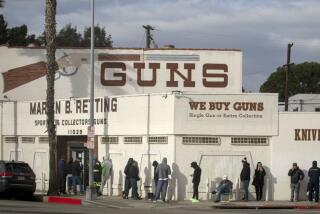Editorial: Here’s how California can get more guns out of dangerous hands

The dramatic rise in gun violence over the last two years in the United States, as was demonstrated in the deadly shootout in Sacramento on Sunday, demands that leaders do more to keep firearms away from dangerous people.
This is no easy task, of course. But California has a system — the only one in the nation — to do so. The Armed and Prohibited Persons System is a state Department of Justice database that tracks firearms owned by people who are banned from possessing them because they’ve been convicted of a felony, are under a restraining order or have a serious mental illness.
Despite numerous obstacles it has demonstrated results, with more than 20,000 guns seized since 2006 from those banned from having them. During a February sweep in Los Angeles, agents took more than 100 guns — including 17 assault weapons and eight “ghost” guns, which are unregistered firearms sold as kits — as well as 49,000 rounds of ammunition from people on the list of prohibited owners.
Community leaders and law enforcement committed to data-driven strategies can reduce gun violence.
This database covers only a portion of gun owners, however: those who bought guns legally and later did something that cost them the right to own a firearm. It isn’t able to track weapons bought on the black market or stolen from legal owners, which are often used in crimes. Although the database tracks only guns that were purchased legally, agents routinely take other guns from prohibited owners when they knock on their doors. Last year, about 42% of the 1,428 firearms seized were not in the system, meaning they were banned weapons or obtained illegally.
But even within its limited universe, the database is not keeping up.
In 2021, a new Department of Justice report says, 8,937 people were removed from the database, either because their weapons were taken, their reason for being prohibited expired or they died. But in the same year, 9,848 new people were added to the list. The total number of people the state knows are armed despite being banned? It now amounts to 24,509 — the highest since tracking began in 2008.
This is more than alarming. The Justice Department agents’ work slowed down during the pandemic’s stay-at-home order, the report says, but returned to pre-pandemic levels in the second half of 2021. The backlog has also grown as California enacted new laws, such as the gun violence restraining order, that prohibit people from having weapons. Meanwhile, homicides have jumped in recent years. In 2020, California reported 30% more homicides than the previous year, and more than 90% of that increase is attributable to gun violence, according to the Public Policy Institute of California. In Los Angeles, gun violence in 2021 hit a 15-year high.
Improving this system is not the only thing the state should do to reduce gun violence. Other tactics are necessary to disrupt illegal gun trafficking and support violence prevention programs that have demonstrated success. Some advocates are calling on the state to boost spending on victim services, substance abuse treatment, street outreach and hospital-based violence interventions. But making the Armed and Prohibited Persons System work better should be high on the list of actions lawmakers and Gov. Gavin Newsom take this year.
California must do more to stop dangerous people from having guns. It’s shameful that California essentially relies on an honor system asking domestic abusers to relinquish their weapons.
They should start by making sure firearms are confiscated from people at the time they’re banned from owning them because of a criminal conviction or restraining order — not months or years later. Though state law requires courts to notify people that they can no longer own a gun at the time they’re convicted, the record is spotty when it comes to getting people to turn in their weapons.
Courts are supposed to assign probation officers to report whether offenders have properly turned in or sold their firearms. In reality, the follow-up is not consistent, which is a reason the list of armed-and-prohibited Californians is so long. Lawmakers should figure out how they can ensure that guns are relinquished at the time people lose their right to own them.
The Legislature should also consider continuing and expanding a grant program it began last year to fund local law enforcement agencies that help reduce the number of armed and prohibited persons by seizing guns and ammo. Last year’s budget provided $10 million to participating sheriff’s departments. The Legislative Analyst‘s Office suggests the program could be expanded to include police departments.
This system alone won’t solve the the pernicious problem of gun violence. But the nation is experiencing an extraordinary wave of killings and suicides, with more Americans dying of gunshots in 2020 than in any year in history. Improving the systems we have in place to take guns from dangerous people is one important way to attack the problem.
More to Read
A cure for the common opinion
Get thought-provoking perspectives with our weekly newsletter.
You may occasionally receive promotional content from the Los Angeles Times.












